 W
WThe Chester Beatty Biblical Papyri or simply the Chester Beatty Papyri are a group of early papyrus manuscripts of biblical texts. The manuscripts are in Greek and are of Christian origin. There are eleven manuscripts in the group, seven consisting of portions of Old Testament books, three consisting of portions of the New Testament, and one consisting of portions of the Book of Enoch and an unidentified Christian homily. Most are dated to the 3rd century. They are housed in part at the Chester Beatty Library in Dublin, Ireland, and in part at the University of Michigan, among a few other locations.
 W
WThe En-Gedi Scroll is an ancient and fragile Hebrew parchment found in 1970 at Ein Gedi, Israel. Radiocarbon testing dates the scroll to the third or fourth century CE, although paleographical considerations suggest that the scrolls may date back to the first or second century CE. This scroll was discovered to contain a portion of the biblical Book of Leviticus, making it the earliest copy of a Pentateuchal book ever found in a Holy Ark. The deciphered text fragment is identical to what was to become during the Middle Ages the standard text of the Hebrew Bible, known as the Masoretic Text, which it precedes by several centuries, and constitutes the earliest evidence of this authoritative text version. Damaged by a fire in approximately 600 CE, the scroll is badly charred and fragmented and required noninvasive scientific and computational techniques to virtually unwrap and read, which was completed in 2015 by a team lead by Prof. Seales of the University of Kentucky.
 W
WPapyrus 1 designated by "𝔓1", "ε 01 ", is an early copy of the New Testament in Greek. It is a papyrus manuscript of the Gospel of Matthew dating palaeographically to the early 3rd century. It is currently housed at the University of Pennsylvania Museum, and was discovered in Oxyrhynchus, Egypt.
 W
WPapyrus 4 is an early New Testament papyrus of the Gospel of Luke in Greek. Opinions differ as to its age. It has been dated anywhere from the late second century to the fourth century.
 W
WPapyrus 5, designated by siglum 𝔓5, is an early copy of the New Testament in Greek. It is a papyrus manuscript of the Gospel of John dating palaeographically to the early 3rd century. The papyrus is housed in the British Library. It has survived in a very fragmentary condition.
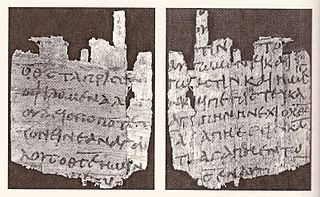 W
WPapyrus 9, signed by 9, and named Oxyrhynchus papyri 402, is an early copy of the New Testament in Greek. It is a papyrus manuscript of the First Epistle of John, dating paleographically to the early 3rd century.
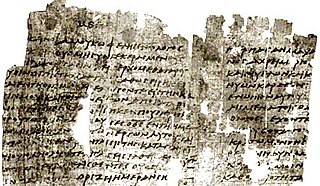 W
WPapyrus 13, designated by siglum 13 or P13 in the Gregory-Aland numbering, is a fragmented manuscript of the New Testament in Greek. It was copied on papyrus in the 3rd century at approximately 225-250 CE.
 W
WPapyrus 15, signed by 15, is an early copy of the New Testament in Greek. It was originally a papyrus manuscript of the Pauline Corpus of letters, but now only contains 1 Corinthians 7:18-8:4. The manuscript has been palaeographically assigned to the 3rd century.
 W
WPapyrus 16, designated by 16, is an early copy of the New Testament in Greek. Originally, it may have been part of a papyrus manuscript of the Pauline Corpus of letters, but now only contains Philippians 3:10-17; 4:2-8. The manuscript has been paleographically assigned to the late 3rd century.
 W
WPapyrus 20, designated by 20, is an early copy of the New Testament in Greek. It is a papyrus manuscript of the Epistle of James, but it only contains Chapter 2:19-3:9. The manuscript has been paleographically assigned to the early 3rd century.
 W
WPapyrus 21, designated by siglum 21, is an early copy of the New Testament in Greek. It is a papyrus manuscript of the Gospel of Matthew, it contains only Matthew 12:24-26.32-33. The manuscript paleographically had been assigned to the early 4th century.
 W
WPapyrus 22, designated by 22, is an early copy of the New Testament in Greek. It is a papyrus manuscript of the Gospel of John, only containing extant John 15:25-16:2, 21-32. The manuscript has been paleographically assigned to the early 3rd century. It is the only identified New Testament papyrus to have been written originally as a roll; not a codex or re-using the back of a scroll.
 W
WPapyrus 23, designated by 23, is an early copy of the New Testament in Greek. It is a papyrus manuscript of the Epistle of James, it contains only James 1:10-12,15-18. The manuscript paleographically has been assigned to the early 3rd century.
 W
WPapyrus 28, designated by 𝔓28, is an early copy of the New Testament in Greek. It is a papyrus manuscript of the Gospel of John, it contains only one leaf with the text of the Gospel of John 6:8-12.17-22. The manuscript paleographically has been assigned to the late 3rd century.
 W
WPapyrus 29, designated by 29, is an early copy of the New Testament in Greek. It is a papyrus manuscript of the Acts of the Apostles which contains Acts 26:7-8 and 26:20. The manuscript paleographically has been assigned to the early 3rd century.
 W
WPapyrus 30, designated by 30, is an early copy of the New Testament in Greek. It is a papyrus manuscript of the Pauline epistles, it contains only 1 Thess 4:12-5:18. 25-28; 2 Thess 1:1-2; 2:1.9-11. The manuscript paleographically has been assigned to the 3rd century.
 W
WPapyrus 39, signed by 39, is an early copy of the New Testament in Greek. It is a papyrus manuscript of the Gospel of John, it contains only John 8:14-22. The manuscript paleographically had been assigned to the 3rd century. Written by professional scribe, in 25 lines per page, in large, beautiful letters. It has numbered pages.
 W
WPapyrus 40, designated by 40, is an early copy of the New Testament in Greek. The manuscript paleographically has been assigned to the 3rd century. It is carelessly written.
 W
WPapyrus 45 is an early New Testament manuscript which is a part of the Chester Beatty Papyri. It has been paleographically dated to the early 3rd century CE. It contains the texts of Matthew 20-21 and 25-26; Mark 4-9 and 11-12; Luke 6-7 and 9-14; John 4-5 and 10-11; and Acts 4-17. The manuscript is currently housed at the Chester Beatty Library, Dublin, Ireland, except for one leaf containing Matt. 25:41-26:39 which is at the Österreichische Nationalbibliothek, Vienna.
 W
WPapyrus 46, scribal abbreviation 46, is an early Greek New Testament manuscript written on papyrus, with its 'most probable date' between 175 and 225. Some leaves are part of the Chester Beatty Biblical Papyri, and others are in the University of Michigan Papyrus Collection.
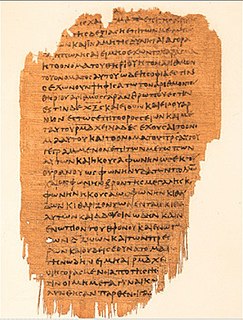 W
WPapyrus 47 (Gregory-Aland), signed by 47, is an early copy of the New Testament in Greek. It is a papyrus manuscript of the Book of Revelation which contains Rev. 9:10-11:3; 11:5-16:15; 16:17-17:2. The manuscript has been assigned paleographically the 3rd century.
 W
WPapyrus 48 (Gregory-Aland), signed by 48, is an early copy of a part of the New Testament in Greek. It is a papyrus manuscript of the Acts of the Apostles, it contains portions of Acts 23:11-29. The manuscript paleographically has been assigned to the 3rd century.
 W
WPapyrus 49 (Gregory-Aland), designated by 49, is an early copy of the New Testament in Greek. It is a papyrus manuscript of the Epistle to the Ephesians, surviving in a fragmentary condition. The manuscript has been palaeographically assigned to the 3rd century. It was probably a part of the same manuscript as Papyrus 65. It came from Egypt and was purchased for the Yale University Library. Textually it is close to the Codex Sinaiticus and Codex Vaticanus. The text of the manuscript has been published several times.
 W
WPapyrus 53, signed by 53, is an early copy of the New Testament in Greek. It is a papyrus manuscript containing parts of the Gospel of Matthew and the Acts of the Apostles: it contains only Matthew 26:29-40 and Acts 9:33-10:1. The manuscript palaeographically had been assigned to the 3rd century. These two fragments were found together, they were part of a codex containing the four Gospels and Acts or Matthew and Acts.
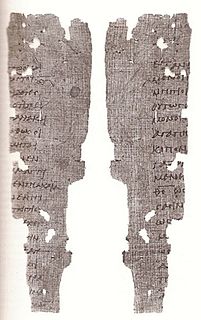 W
WPapyrus 65, designated by 65, is a copy of the New Testament in Greek. It is a papyrus manuscript of the First Epistle to the Thessalonians. The surviving texts of the epistle are the verses 1:3-2:1 and 2:6-13. The manuscript has been assigned on palaeographic grounds to the 3rd century.Text
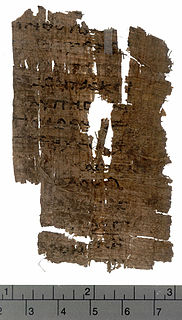 W
WPapyrus 69 is a small fragment from the Gospel of Luke dating to the 3rd century.
 W
WPapyrus 70, designated by 70, is an early copy of the New Testament in Greek. It is a papyrus manuscript of the Gospel of Matthew. The surviving texts of Matthew are verses 2:13-16; 2:22-3:1; 11:26-27; 12:4-5; 24:3-6.12-15. 70 has a fairly reliable text, though it was carelessly written. The manuscript palaeographically had been assigned to the late 3rd century.Text
 W
WPapyrus 72 is the designation used by textual critics of the New Testament to describe portions of the so-called Bodmer Miscellaneous codex, namely the letters of Jude, 1 Peter, and 2 Peter. These books seem to have been copied by the same scribe, and the handwriting has been paleographically assigned to the 3rd or 4th century. Although the letters of Jude and 1-2 Peter in this codex do not form a single continuous text, scholars still tend to refer to these three texts as a single early New Testament papyrus.
 W
WPapyrus 77, designated by 77, is a papyrus manuscript of the Gospel of Matthew verses 23:30-39. It is written in Greek and has palaeographically been assigned a date anywhere from the middle 2nd century to the early 3rd century.
 W
WPapyrus 78, designated by 78, is an early copy of the New Testament in Greek. It is a papyrus manuscript of the Epistle of Jude. The surviving texts of Jude are verses 4-5 & 7-8. 78 is written in an elegant hand. The manuscript has been paleographically assigned to the 3rd century.
 W
WPapyrus 87, designated by 87, is an early New Testament papyrus. It is the earliest known manuscript of the Epistle to Philemon. The surviving texts of Philemon are verses 13-15, 24-25.
 W
WPapyrus 92, designated by 92, is an early New Testament papyrus.
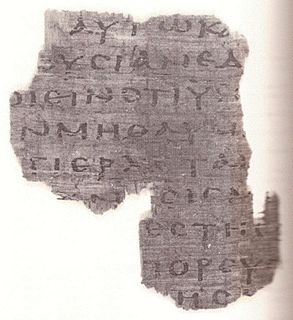 W
WPapyrus 95, designated by siglum 95, is an early copy of the New Testament in Greek. It is a papyrus manuscript of the Gospel of John. The surviving texts of John are verses 5:26-29,36-38. The manuscript palaeographically has been assigned to the early 3rd century.
 W
WPapyrus 100, designated by siglum 100, is an early copy of the New Testament in Greek. It is a papyrus manuscript of the Epistle of James. The surviving texts of James are verses 3:13-4:4; 4:9-5:1, they are in a fragmentary condition. The manuscript has been assigned paleographically to the late 3rd century, or early 4th century.
 W
WPapyrus 101, designated by 101, is an early copy of the New Testament in Greek. It is a papyrus manuscript of the Gospel of Matthew. The surviving texts of Matthew are verses 3:10-12; 3:16-4:3, they are in a fragmentary condition. The manuscript palaeographically has been assigned to the 3rd century.Text
 W
WPapyrus 102, designated by 102, is an early copy of the New Testament in Greek. It is a papyrus manuscript of the Gospel of Matthew. The surviving texts of Matthew are verses 4:11-12; 4:22-23, they are in a fragmentary condition. The manuscript palaeographically has been assigned to the 3rd century.
 W
WPapyrus 103, designated by 103, is a copy of part of the New Testament in Greek. It is a papyrus manuscript of the Gospel of Matthew.
 W
WPapyrus 106, designated by 106, is a copy of the New Testament in Greek. It is a papyrus manuscript of the Gospel of John, containing verses 1:29-35 & 1:40-46 in a fragmentary condition. The manuscript has been paleographically assigned to the early 3rd century. The manuscript is currently housed at the Sackler Library at Oxford.
 W
WPapyrus 107, designated by 107, is a copy of the New Testament in Greek. It is a papyrus manuscript of the Gospel of John, containing verses 17:1-2 & 17:11 in a fragmentary condition. The manuscript has been paleographically assigned to the early 3rd Century CE. The manuscript currently is housed at the Sackler Library at Oxford.
 W
WPapyrus 108, designated by 108, is a copy of the New Testament in Greek. It is a papyrus manuscript of the Gospel of John, containing verses 17:23-24 & 18:1-5 in a fragmentary condition. The manuscript has been paleographically assigned to the late 2nd or early 3rd Century CE. The manuscript is currently housed at the Papyrology Rooms of the Sackler Library at Oxford University.
 W
WPapyrus 109, designated by siglum 109, is a copy of the New Testament in Greek. It is a papyrus manuscript of the Gospel of John, containing verses 21:18-20 & 21:23-25 in a fragmentary condition. The manuscript has been palaeographically assigned by the INTF to the early 3rd century CE. Papyrologist Philip Comfort dates the manuscript to the middle-late 2nd century CE. The manuscript is currently housed at the Papyrology Rooms of the Sackler Library at Oxford.
 W
WPapyrus 111, designated by 111, is a copy of the New Testament in Greek. It is a papyrus manuscript of the Gospel of Luke, containing verses 17:11-13 & 17:22-23 in a fragmentary condition. The manuscript has been paleographically assigned by the INTF to the 3rd Century CE. Papyrologist Philip Comfort dates the manuscript to the first half of the 3rd century CE. The manuscript is currently housed at the Sackler Library at Oxford.
 W
WPapyrus 113, designated by 113, is a fragment of an early copy of a section of the New Testament in Greek. It comes from a papyrus manuscript of the Epistle to the Romans. The surviving text features parts of Romans 2:12-13 on one side of the fragment and parts of 2:29 on the other.
 W
WPapyrus 114, designated by 114, is a copy of the New Testament in Greek. It is a papyrus manuscript of the Letter to the Hebrews, containing verses 1:7-12 in a fragmentary condition. The manuscript has been paleographically assigned by the INTF to the 3rd century CE. Papyrologist Philip Comfort dates the manuscript to Middle-Late 3rd century CE. The manuscript is now in the Papyrology Rooms of the Sackler Library at Oxford.
 W
WPapyrus 115 is a fragmented manuscript of the New Testament written in Greek on papyrus. It consists of 26 fragments of a codex containing parts of the Book of Revelation, and probably nothing more. It dates to the third century, c. 225-275 AD. Grenfell and Hunt discovered the papyrus in Oxyrhynchus, Egypt.
 W
WPapyrus 118, designated by 118, is a copy a small part of the New Testament in Greek. It is a papyrus manuscript of the Epistle to the Romans. The surviving text of Romans are verses 15:26-27,32-33; 16:1,4-7,11-12. They are in a fragmentary condition. The manuscript paleographically had been assigned by the INTF to the 3rd century.Text
 W
WPapyrus 119, designated by 119, is an early copy of a small part of the New Testament in Greek found among the Oxyrhynchus Papyri. It is a manuscript of the Gospel of John.
 W
WPapyrus 121, designated by 121, is an early copy of the New Testament in Greek. It is a papyrus manuscript of the Gospel of John. The surviving texts of John are only fragments of verses 19:17-18,25-26. They are in very fragmentary condition. The manuscript paleographically has been assigned to the 3rd century by the INTF.
 W
WPapyrus 137, designated by 137, is an early fragment of the New Testament in Greek. The fragment is from a codex, written on both sides with text from the first chapter of the Gospel of Mark; verses 7-9 on the recto side and 16-18 on the verso side. The manuscript has been dated paleographically to the later 2nd or earlier 3rd century, and has been published in the Oxyrhynchus papyrus series as P.Oxy. LXXXIII 5345.
 W
WPapyrus 967 is a 3rd-century biblical manuscript, discovered in 1931. It is notable for containing fragments of the original Septuagint text of the Book of Daniel, which was completely superseded by a revised text by the end of the 4th century and elsewhere survives only in Syriac translation and in Codex Chisianus 88. The manuscript is also important for early variants, both in the text of the Book of Ezekiel and of the Book of Daniel.
 W
WPapyrus Oxyrhynchus 656 – is a Greek fragment of a Septuagint manuscript written on papyrus in codex form. This is a manuscript discovered at Oxyrhynchus, and it has been catalogued with number 656. Palaeographycally it is dated to late second century or early third century.
 W
WPapyrus Oxyrhynchus 1007 is a fragment of a Septuagint manuscript (LXX) written in two columns on a parchment codex. The manuscript was discovered in Oxyrhynchus, modern El-Bahnasa, Egypt. The manuscript has been palaeographically dated to the 3rd century CE.
 W
WPapyrus Oxyrhynchus L 3525 is a copy of the apocryphal Gospel of Mary in Greek. It is a papyrus manuscript formed in a roll. The manuscript had been assigned palaeographically to the 3rd century. It is one of the three manuscripts and one of the two Greek manuscripts of the Gospel of Mary. It is shorter than Papyrus Rylands 463.
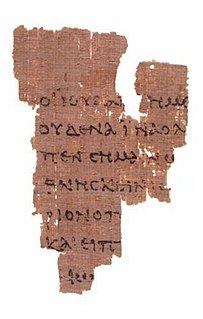 W
WThe Rylands Papyri are a collection of thousands of papyrus fragments and documents from North Africa and Greece housed at the John Rylands University Library, Manchester, UK. The collection includes the Rylands Library Papyrus P52, also known as the "St John's fragment", a fragment from a papyrus codex, generally accepted as the earliest extant record of a Canonical gospel.
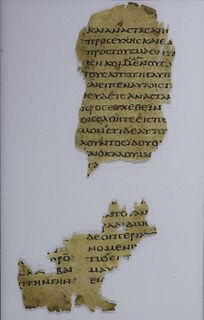 W
WUncial 0171, ε 07 (Soden) are two vellum leaves of a late third century Greek uncial Bible codex containing fragments of the Gospel of Matthew and the Gospel of Luke. Luke fragment, in two parts, is preserved in the Laurentian Library collection in Florence, and the Matthew fragment is in the Berlin State Museum.
 W
WUncial 0189, is the oldest parchment manuscript of the New Testament.
 W
WDura Parchment 24, designated as Uncial 0212, is a Greek uncial manuscript of the New Testament. The manuscript has been assigned to the 3rd century, palaeographically, though an earlier date cannot be excluded. It contains some unusual orthographic features, which have been found nowhere else.
 W
WUncial 0220, also known as the Wyman fragment, is a leaf of a third-century Greek codex containing The Epistle to the Romans.